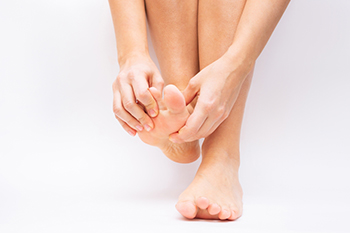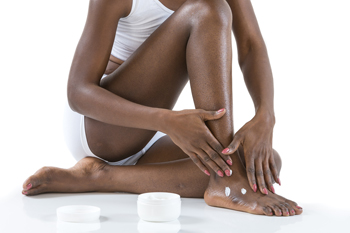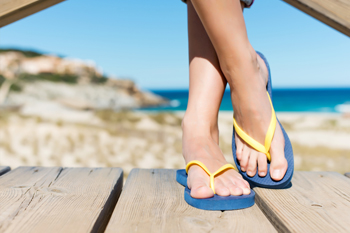August 2022
Arthritis in the Big Toe

The big toe plays an important role in our ability to walk and remain balanced. The place where the big toe connects to the foot is called the metatarsophalangeal joint (MTP). This joint, like many others in the body, is often the target of osteoarthritis because it gets a lot of wear and tear. Symptoms include pain (especially while active), stiffness, swelling, and a shifting of weight when you walk (change in gait). Occasionally, the big toe pushes toward the other toes, forming a bunion. Stiffness in the joint can result in a difficulty walking, which then can lead to the formation of calluses, corns, and hammertoes. The risk of developing osteoarthritis increases as you age, but other factors such as genetics, obesity, and prior joint injury can contribute to it. As with any progressive disease, osteoarthritis in the big toe can only become worse. Getting treatment from a podiatrist as early as possible is a good idea. X-rays can often detect the extent of the damage to the MTP joint and help the doctor to determine treatment options. Among them are certain prescription medications, changes in footwear, and in severe cases, surgery. For more information on osteoarthritis of the big toe, please consult a podiatrist.
Toe pain can disrupt your daily activities. If you have any concerns, contact John Killough, DPM of Regional Foot Center. Our doctor can provide the care you need to keep you pain-free and on your feet.
What Causes Toe Pain?
Most severe toe pain is caused due to a sports injury, trauma from dropping something heavy on the toe, or bumping into something rigid. Other problems can develop over time for various reasons.
Toe pain can be caused by one or more ailments. The most common include:
- Trauma
- Sports injury
- Wearing shoes that are too tight
- Arthritis
- Gout
- Corns and calluses
- Hammertoe
- Bunions
- Blisters
- Ingrown toenails
- Sprains
- Fractures (broken bones)
- Dislocations
When to See a Podiatrist
- Severe pain
- Persistent pain that lasts more than a week
- Signs of infection
- Continued swelling
- Pain that prevents walking
Diagnosis
In many cases the cause of toe pain is obvious, but in others, a podiatrist may want to use more advanced methods to determine the problem. These can range from simple visual inspections and sensation tests to X-rays and MRI scans. Prior medical history, family medical history, and any recent physical traumatic events will all be taken into consideration for a proper diagnosis.
Treatment
Treatments for toe pain and injuries vary and may include shoe inserts, padding, taping, medicines, injections, and in some cases, surgery. If you believe that you have broken a toe, please see a podiatrist as soon as possible.
If you have any questions please feel free to contact our offices located in Charleston and Effingham, IL . We offer the newest diagnostic tools and technology to treat your foot and ankle needs.
Little Known Facts About Clubfoot

Clubfoot is a congenital birth defect. The shape of the baby’s foot points down and is turned in. This happens because the tissues that connect the bone to the muscles in the leg are defective in some way. The tendons are shorter than they should be so the foot is pulled into an abnormal position. There may be additional changes to the ankle joint, bone of the foot, and muscles with clubfoot. Male babies are twice as likely to develop clubfoot at birth than females. A little less than half of those born with a clubfoot will suffer this condition in both feet. Having another birth defect, such as cerebral palsy or spina bifida, increases the chances of a baby being born with clubfoot. Infections during pregnancy, smoking, or using drugs can also increase the likelihood of this defect. This can be a genetic birth defect, especially if there is a family history on the father’s side of the family. Clubfoot has a higher incidence of occurrence in countries with lower incomes. Those born in Hawaii are six times more likely to be born with clubfoot, and those born in Japan are 50% less likely to be born with clubfoot. Clubfoot can be cured but this is not always the case. If your child is born with clubfoot, include a podiatrist on your healthcare team for proper diagnosis and treatment as soon as possible. Early intervention can make a difference.
Congenital foot problems require immediate attention to avoid future complications. If you have any concerns, contact John Killough, DPM of Regional Foot Center. Our doctor can provide the care you need to keep you pain-free and on your feet.
Congenital foot problems are deformities affecting the feet, toes, and/or ankles that children are born with. Some of these conditions have a genetic cause while others just happen. Some specific foot ailments that children may be born with include clubfeet, polydactyly/macrodactyly, and cleft foot. There are several other foot anomalies that can occur congenitally. What all of these conditions have in common is that a child may experience difficulty walking or performing everyday activities, as well as trouble finding footwear that fits their foot deformity. Some of these conditions are more serious than others. Consulting with a podiatrist as early as possible will help in properly diagnosing a child’s foot condition while getting the necessary treatment underway.
What are Causes of Congenital Foot Problem?
A congenital foot problem is one that happens to a child at birth. These conditions can be caused by a genetic predisposition, developmental or positional abnormalities during gestation, or with no known cause.
What are Symptoms of Congenital Foot Problems?
Symptoms vary by the congenital condition. Symptoms may consist of the following:
- Clubfoot, where tendons are shortened, bones are shaped differently, and the Achilles tendon is tight, causing the foot to point in and down. It is also possible for the soles of the feet to face each other.
- Polydactyly, which usually consists of a nubbin or small lump of tissue without a bone, a toe that is partially formed but has no joints, or an extra toe.
- Vertical talus, where the talus bone forms in the wrong position causing other bones in the foot to line up improperly, the front of the foot to point up, and the bottom of the foot to stiffen, with no arch, and to curve out.
- Tarsal coalition, when there is an abnormal connection of two or more bones in the foot leading to severe, rigid flatfoot.
- Cleft foot, where there are missing toes, a V-shaped cleft, and other anatomical differences.
- Macrodactyly, when the toes are abnormally large due to overgrowth of the underlying bone or soft tissue.
Treatment and Prevention
While there is nothing one can do to prevent congenital foot problems, raising awareness and receiving neonatal screenings are important. Early detection by taking your child to a podiatrist leads to the best outcome possible.
If you have any questions please feel free to contact our offices located in Charleston and Effingham, IL . We offer the newest diagnostic tools and technology to treat your foot and ankle needs.
What Is Dyshidrotic Eczema?

Blisters can affect many parts of the body including the feet, and they occur when small amounts of liquid accumulate in between layers of skin. Dyshidrotic eczema is an important type of blister to be aware of that can affect the feet. This condition can form small, itchy blisters on the toes and the bottom of the feet. Dyshidrotic eczema can take form on the hands as well. If you are suffering from this condition, you might experience several different symptoms. You may notice that the affected area on your feet has changed color, becoming red. You might also notice that the skin has changed texture, becoming scaly and dry. The exact cause of dyshidrotic eczema remains somewhat elusive. However, it may be connected to conditions like hay fever. Of course, dyshidrotic eczema is just one kind of blister that can take shape on the feet. Many other kinds of blisters can develop on your feet through friction being applied, for example, by wearing ill-fitting shoes that rub against the skin. Blisters from dyshidrotic eczema or any other condition are nothing to take lightly. Talk to a podiatrist if you have blisters on your feet. They can help you address the issue.
Blisters are prone to making everyday activities extremely uncomfortable. If your feet are hurting, contact John Killough, DPM of Regional Foot Center. Our doctor can provide the care you need to keep you pain-free and on your feet.
Foot Blisters
Foot blisters develop as a result of constantly wearing tight or ill-fitting footwear. This happens due to the constant rubbing from the shoe, which can often lead to pain.
What Are Foot Blisters?
A foot blister is a small fluid-filled pocket that forms on the upper-most layer of the skin. Blisters are filled with clear fluid and can lead to blood drainage or pus if the area becomes infected.
How Do Blisters Form?
Blisters on the feet are often the result of constant friction of skin and material, usually by shoe rubbing. Walking in sandals, boots, or shoes that don’t fit properly for long periods of time can result in a blister. Having consistent foot moisture and humidity can easily lead to blister formation.
Prevention & Treatment
It is important to properly care for the affected area in order to prevent infection and ease the pain. Do not lance the blister and use a Band-Aid to provide pain relief. Also, be sure to keep your feet dry and wear proper fitting shoes. If you see blood or pus in a blister, seek assistance from a podiatrist.
If you have any questions, please feel free to contact our offices located in Charleston and Effingham, IL . We offer the newest diagnostic and treatment technologies for all your foot care needs.
The Feet Can Be Likened to a Work of Art

There are 26 bones in each foot, accompanied by several joints, tendons, muscles, and ligaments. The feet comprise 25% of all the bones in the body, and it is important to practice everyday foot care that can benefit the entire body. The feet can be likened to a machine, and the muscles and joints can represent pulleys and levers that can move side to side and up and down. This is instrumental in walking, running, and completing everyday activities, and many people have considered the feet to be a “work of art." As the aging process occurs, the feet may start to wear and tear, and uncomfortable foot conditions may develop. Dry skin can possibly be reduced when a good moisturizer is used on them daily. Additionally, the chances of getting athlete’s foot and toenail fungus may decrease when appropriate shoes are worn in public swimming pool and locker room areas. It is beneficial to wear shoes that fit correctly, and this may help to prevent hammertoe and bunions from developing. Additionally, the feet will feel good at the end of the day when they are soaked in warm water and scented oil. For more information about everyday foot care tips, it is suggested that you speak with a podiatrist who can provide you with answers to any questions you may have.
Everyday foot care is very important to prevent infection and other foot ailments. If you need your feet checked, contact John Killough, DPM from Regional Foot Center. Our doctor can provide the care you need to keep you pain-free and on your feet.
Everyday Foot Care
Often, people take care of their bodies, face and hair more so than they do for their feet. But the feet are a very important aspect of our bodies, and one that we should pay more attention to. Without our feet, we would not be able to perform most daily tasks.
It is best to check your feet regularly to make sure there are no new bruises or cuts that you may not have noticed before. For dry feet, moisturizer can easily be a remedy and can be applied as often as necessary to the affected areas. Wearing shoes that fit well can also help you maintain good foot health, as well as making it easier to walk and do daily activities without the stress or pain of ill-fitting shoes, high heels, or even flip flops. Wearing clean socks with closed shoes is important to ensure that sweat and bacteria do not accumulate within the shoe. Clean socks help to prevent Athlete’s foot, fungi problems, bad odors, and can absorb sweat.
If you have any questions please feel free to contact our offices located in Charleston and Effingham, IL . We offer the newest diagnostic and treatment technologies for all your foot and ankle needs.
Are Bunions Affecting Your Everyday Life?
Flip-Flops and Bacteria

Despite their stylish appeal and popularity during the warm summer months, flip-flops can present several threats to the health of your feet. Since flip-flops lack a back strap, the wearer must scrunch their toes to keep the shoe on the feet. These toe contortions can cause pain and complications. Additionally, since flip-flops are but mere pieces of flat foam, they offer little to no support. You might, therefore, experience increased stress on the heel when walking with flip-flops because they offer no padding or cushioning. One often overlooked downside of wearing flip-flops is the extent to which they can accumulate bacteria. Especially if worn in cities, flip-flops can accumulate many different kinds of bacteria both on the top and bottom of the foam. If worn in cities during warm months and rainy seasons, environmental moisture will only help the bacteria thrive. Since flip-flops are open toed shoes that ultimately expose your entire foot, this accumulation of bacteria can be especially dangerous to your feet. Contact your podiatrist who will be able to help you select healthy summer footwear.
Flip-flops are not always the best choice of footwear. If you have any concerns about your feet or ankles, contact John Killough, DPM from Regional Foot Center. Our doctor will assist you with all of your foot and ankle needs.
Flip-Flops and Feet
When the weather starts warming up, people enjoy wearing flip-flops. Flip-flops are comfortable, stylish, and easy to slip on and off; they're perfect for any summer beach goer. However, these shoes can cause harm to the feet.
How Can Flip-Flops Affect Me Long-Term?
- Ankle problems
- Hip problems
- Lower back problems
- Pain in the balls of the feet
- Problems with foot arches
- Changes in the way you walk
Are There Injuries Associated with Flip-Flops?
Yes. Since flip-flops are relatively weak and do not provide the same amount of support as sneakers, people who wear flip-flops regularly are more susceptible to injuries. On top of that, the open nature of the shoe makes your feet more prone to other problems, such as cuts and even infections. Common injuries and ailments include:
- Sprained ankles
- Blisters
- Infections
- Cuts and Scrapes
I like Wearing Flip-Flops. Are There Safe Alternatives?
When buying flip-flops, try to find ones that have sturdy soles and that are made of high-quality materials that will support for your feet. These flip-flops will cost more but will also last longer as a result.
If you have any questions please feel free to contact our offices located in Charleston and Effingham, IL . We offer the newest diagnostic and treatment technologies for all your foot and ankle needs.





